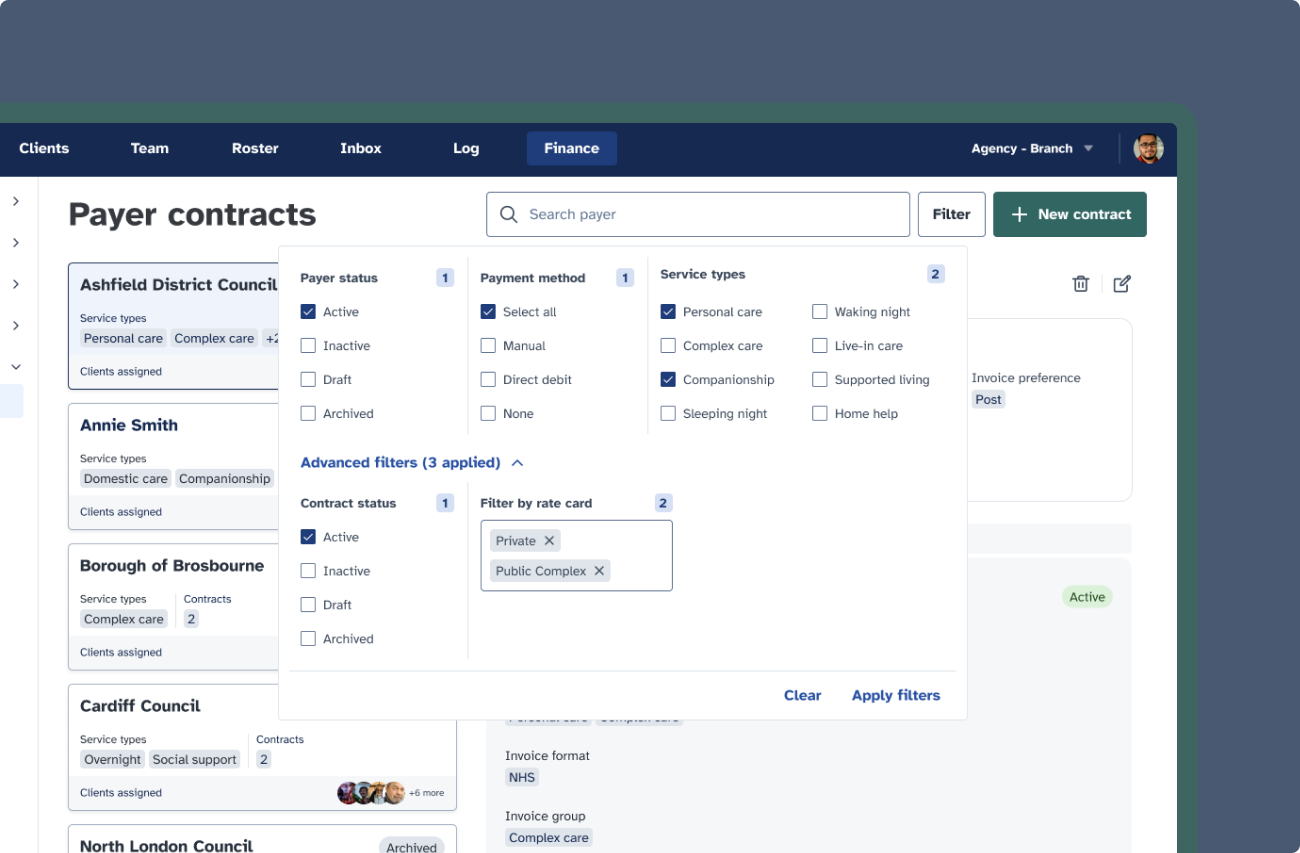Context
During my time at Birdie, I contributed to shaping the vision for Birdie Finance—a product designed to help care agencies optimise costs while maintaining care quality. While this vision wasn’t fully realised during my time there, it provided essential direction, helping guide strategic choices and laying the foundation for future development.
Competing in a market filled with established payroll and invoicing tools was a challenge, but Birdie Finance stood out by focusing on the unique data we held on social care. As part of a collaborative team, my role was to help articulate how the product could address the critical lack of cost visibility in care operations. By aligning Birdie Finance with Birdie Care Plan and Scheduling, which supports care quality, we envisioned a solution that could balance financial and operational goals, offering care agencies something truly unique.
This project highlighted the importance of design in shaping strategy and aligning solutions with a clear purpose.



Research & Discovery

Stakeholders
- External: Small, medium, and large enterprise users; finance managers; care managers; care coordinators.
- Internal: Engineering, sales, onboarding, and customer success teams.
User Interviews
- Moderated sessions led by design and product management to explore approaches to funding in social care.
- Methods:
- Affinity Mapping: Identified shared themes and pain points across customer types.
- Abstraction: Replaced specific terminology with universally understood concepts to ensure solution scalability.
Outcome
- Clearly framed the problem.
- Delivered a concise and actionable design brief.
MAIN TAKEAWAYS
- Agencies manage funding differently, depending on the type of care, funder, and client needs.
- No competitor successfully addressed this challenge, giving us a strong business advantage.
- To expand, our solution needed to be scalable—avoiding custom-built fixes and instead offering a modular, configurable system that could adapt to different scenarios without starting from scratch each time.

Problem
Our finance product allowed multiple funders per client, but users had to split care costs, which was time-consuming and error-prone manually. Additionally, the system lacked clear visibility into how many funders were involved, causing confusion and inefficiency in tracking contributions.
How might we automate splitting care costs among multiple funders to reduce manual work and errors?


Solution
A modular, time-saving system that simplifies data input by reducing three layers to two: one for payer details and one for client funding details. It supports multiple contracts per client, enabling funding splits. Additionally, it creates the foundation to introduce budgets with predefined percentages, paving the way for automatic invoice splitting in the future.



Iterations
1. Enhanced filtering mechanism

To address the need for a robust filtering component without overwhelming the interface, we introduced a new design system component that balances functionality and space efficiency. The filter now overlays the interface only when activated and remains tucked away under a “Filter” button when not in use. This approach not only optimizes screen real estate but also ensures scalability by accommodating advanced filtering capabilities in the same interface. This iteration not only improved usability but also enriched our design system with a versatile, reusable component.

2. Streamlined empty state experience

User testing revealed that presenting too much information upfront created a sense of overwhelm. To mitigate this, we reimagined the empty state by avoiding the population of the right-hand panel until the user takes an intentional action. The panel dynamically updates only after the user selects an item on the left. This approach reduced cognitive load and fostered a more focused, user-driven interaction flow, enhancing overall clarity and engagement.

Future considerations
1. Optimized side navigation
Enhancing the side navigation to support better wayfinding and scalability is a priority. Implementing more intuitive grouping and collapsible sections can streamline access to key features while maintaining a clean and organized interface.
2. Progressive contracts view
Evolving the contracts view to adopt a progressive disclosure approach will help users focus on relevant details at the right time. By displaying high-level summaries upfront and allowing deeper layers of information to unfold on demand, we can reduce cognitive load and make complex data easier to digest.
3. Contextual controls
Introducing hover-triggered controls is an opportunity to minimize visual clutter and improve focus. By displaying actions and settings contextually only when needed, we can further refine the interface and create a cleaner, more intuitive user experience.
These considerations align with the overarching goal of enhancing usability, clarity, and scalability, ensuring the solution continues to evolve with user needs.

4. Simplified filtering via grouping
Introducing a “Needs Review” grouping within the filtering system can streamline workflows by consolidating high-priority items in a single view. This targeted approach would enable users to quickly identify and address actionable tasks, reducing the time spent navigating through multiple filters and enhancing overall efficiency. This enhancement aligns with the goal of making the system more intuitive and focused on user priorities.


Measuring success

The success of the new funding management system is currently under evaluation. The primary metric is achieving a 100% adoption rate among customers transitioning to the new system. During an initial three-month period, both the old and new systems were made available to provide flexibility and facilitate a smoother transition.
In parallel, we have been gathering qualitative feedback from key users. Notably, no significant pain points have been raised thus far, indicating a positive reception. This dual approach ensures both quantitative and qualitative insights are captured, allowing for a comprehensive evaluation of the solution’s impact.






















